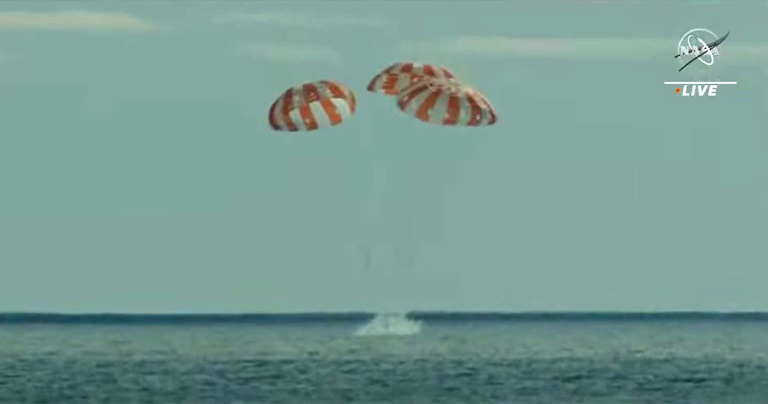In this still image taken from NASA TV, NASA's unmanned Orion spaceship splashes down in the Pacific Ocean off Baja California, Mexico, on December 11, 2022
NASA’s Orion space capsule splashed down safely in the Pacific on Sunday, completing the Artemis 1 mission — a more than 25-day journey around the Moon with an eye to returning humans there in just a few years.
After racing through the Earth’s atmosphere at a speed of 25,000 miles per hour (40,000 kilometers per hour), the uncrewed capsule floated down to the sea with the help of three large red and orange parachutes, as seen on NASA TV.
“NASA we had a picture perfect splashdown,” said Melissa Jones, NASA’s landing and recovery director.
During the trip around Earth’s orbiting satellite and back, Orion logged well over a million miles and went farther from Earth than any previous habitable spacecraft.
“For years, thousands of individuals have poured themselves into this mission, which is inspiring the world to work together to reach untouched cosmic shores,” said NASA Administrator Bill Nelson.
“Today is a huge win for NASA, the United States, our international partners, and all of humanity,” he added.
After touchdown, helicopters flew over the floating spacecraft, which showed no evidence of damage.
Orion will be recovered by a prepositioned US Navy ship off the coast of Mexico’s Baja California after some initial tests are run.
As it reentered the Earth’s atmosphere, the gumdrop-shaped capsule had to withstand a temperature of 2,800 degrees Centigrade (5,000 Fahrenheit) — about half that of the surface of the Sun.
The main goal of this mission was to test Orion’s heat shield — for the day when it is humans and not test mannequins riding inside.
Achieving success in this mission was key for NASA, which has invested tens of billions of dollars in the Artemis program due to take people back to the Moon and prepare for an onward trip, someday, to Mars.
A first test of the capsule was carried out in 2014 but that time it stayed in Earth’s orbit, coming back into the atmosphere at a slower speed of around 20,000 miles per hour.
– Choppers, divers and boats –
The USS Portland was positioned to recover the Orion capsule in an exercise NASA has been rehearsing for years. Helicopters and inflatable boats were also deployed.
The falling spacecraft eased to a speed of 20 miles per hour as it finally hit the Pacific’s blue waters.
NASA then planned to let Orion float for two hours — a lot longer than if astronauts were inside — to collect data.
“We’ll see how the heat soaks back into the crew module and how that affects the temperature inside,” Jim Geffre, NASA’s Orion vehicle integration manager, said last week.
Divers will then attach cables to hoist Orion onto the USS Portland, an amphibious transport dock vessel whose stern will be partly submerged. This water will be pumped out slowly so the spacecraft can rest on a platform designed to hold it.
This should all take about four to six hours after splashdown.
The Navy ship will then head for San Diego, California where the spacecraft will be unloaded a few days later.
Orion has now traveled 1.4 million miles since it took off from the east coast of Florida on November 16, aided by the monstrous rocket called SLS.
At its nearest point to the Moon, it flew less than 80 miles from the surface. And it broke the distance record for a habitable capsule from our planet, venturing 268,000 miles away at its farthest point.
– Artemis 2 and 3 –
Recovering the spacecraft will allow NASA to gather data that is crucial for future missions.
This includes information on the condition of the vessel after its flight, data from monitors that measure acceleration and vibration, and the performance of a special vest put on a mannequin in the capsule to test how to protect people from radiation while flying through space.
Some capsule components should be good for reuse in the Artemis 2 mission, already in advanced stages of planning.
That mission, planned for 2024, will take a crew toward the Moon but still without landing on it. NASA is expected to name the chosen astronauts soon.
Artemis 3, scheduled for 2025, will see a spacecraft land for the first time on the south pole of the Moon, where they hope to find water in the form of ice.
As part of the Artemis missions, NASA is planning send a woman and a person of color to the Moon for the first time.
Only 12 people — all of them white men — have set foot on the Moon. That was during NASA’s historic Apollo missions, which ended in 1972.
NASA hopes to establish a lasting human presence on the Moon, through a base on the surface as well as an orbiting space station. Having people learn to live on the Moon should help engineers develop technologies for a years-long trip to Mars, possibly in the late 2030s.









